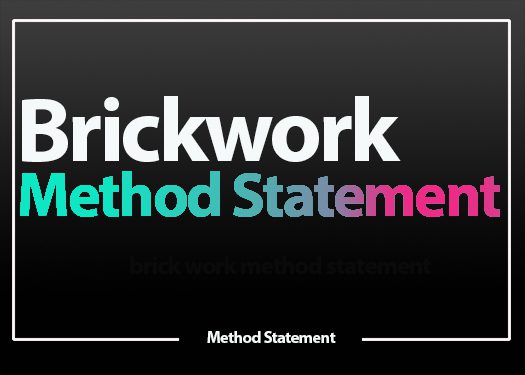Table of Contents
What is Brickwork Method Statement
This method statement aims to ensure that brickworks are installed correctly and inspected thoroughly in accordance with the construction drawings, specifications, and industry best practices.
Tools
Before starting the bricklaying work, the following tools and materials must be readily available:
Brick hammer
Trowel Set
Cement edgers
Brick jointer
The average compressive strength of the bricks tested shall be no less than 5.2 N/mm2. The average size of the bricks in a batch should be consistent with the sample size of 24 bricks tested.
See Also: MS for Blockworks / Masonry
Procedure
To begin the brickwork process, the construction drawings must be reviewed to understand the dimensioning and setting out. It must be coordinated with mechanical, plumbing, electrical services, and other architectural elements.
The cement mortar mixed ratio must be checked to ensure it aligns with the specifications in the drawing. Additionally, it must be set out with reference to the grid lines and columns.
Before laying, the position of the stiffener (if needed) must be located and cast. It is important to check the installation of the damp proof course on the ground floor, ensuring that a layer of bituminous compound is laid on the concrete floor base before laying the bituminous felt and the 12mm thick base cement mortar.
The exmet wire and tie rod must be bedded at every fourth course, and proper lapping of the joining exmet wire must be ensured.
The bricklaying partition height and ceiling beam height must be checked to ensure they are laid with bricks 100 mm above ceiling level.
The consistency of the 12 mm thick cement mortar bedded on bricks must be checked to ensure that no four courses rise more than 300mm in height.
The joints must be deeply raked to 19 mm during construction, and the stopped end wall, junction wall, and intersection wall must be checked for proper bonding.
See Also: MS for Civil Engineering

Health & Safety Requirements for Bricklaying
Health and safety are paramount during bricklaying. Therefore, it is essential to establish a clear access and egress way to safely move brick packs and other materials and equipment around the site.
Material delivery and storage areas must have enough space and lighting to enable the safe movement of materials. Additionally, safe work practices must be developed and maintained to reduce the risk of injury.
Staff should not manually lift and handle equipment when it is required. Suitable tools and equipment must always be used for the job.
Welfare and first aid facilities, such as site cabins with water closets and washing facilities, should be available on-site with a main contractor first aid box and trained first aiders.
Reducing risk should be a priority, and using mechanical means where possible, continual use of PPE, good housekeeping practices, and continual inspection of plants and tools should be implemented.
Health, safety, and environmental assessments, such as manual handling, use of cement mixer, dermatitis, and burns from cement, and COSHH Assessment of cement and silica dust, must be performed.
The site supervisor should supervise the work; all staff involved must receive the required training.
The number of labourers required, hand tools, scaffolding (if required and inspected daily), wheelbarrows, cement mixer, 110V grinder, mechanical block cutter/splitter, all-terrain forklift (if required), telescopic (telehandler) vehicle (if required), electric hoist (Genie) (if required), trestles and boards, and laser level (if required) must be determined before beginning the process.
In case of emergencies, the supervisor must have a mobile phone available to summon assistance.
This MS will be the subject of a toolbox talk given to all personnel involved in the work activity.
FAQs
What should be included in a Brickwork Method Statement?
A Method Statement should include a description of the scope of work, the sequence of activities, materials, and equipment needed, the procedures for ensuring safety, and any environmental or quality control requirements. It should also identify any risks and hazards and the steps that will be taken to mitigate them.
tag: # brick, work, bricks, works, masonry, wall, brick, mortar, safety, concrete, inspection, masonry, cement, castable, tools, refractory, bricklaying, hse, lintel, temperature, risk assessment
